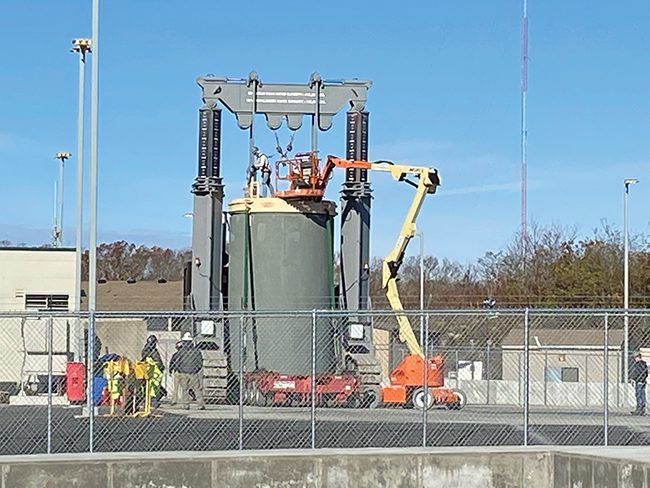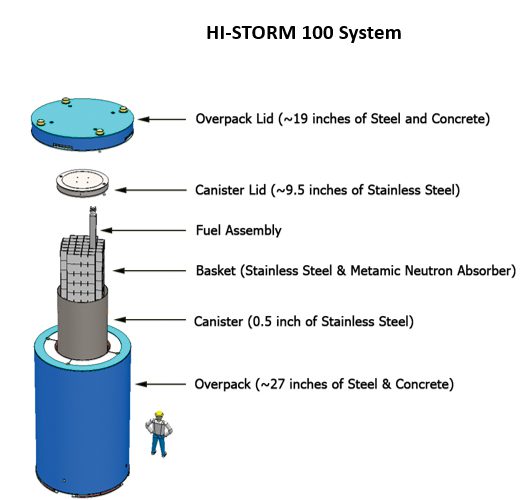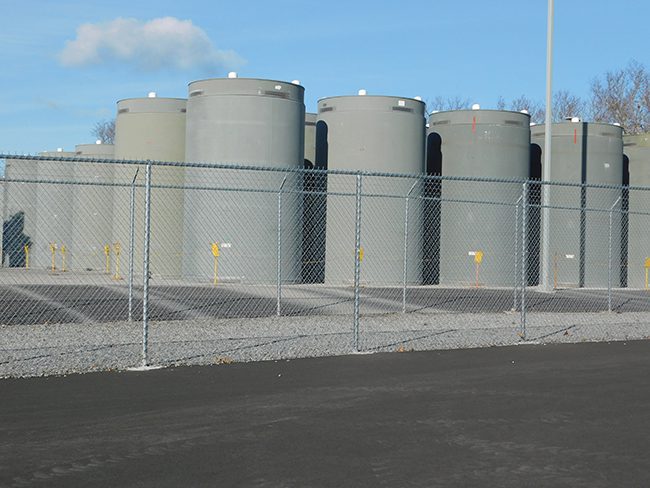Accelerated Decommissioning of Pilgrim Nuclear Power Station: A Progress Report
Credit to Author: POWER| Date: Tue, 01 Mar 2022 05:12:00 +0000

Holtec is decommissioning the Pilgrim Nuclear Power Station. The company has a fairly aggressive schedule that could see site restoration work completed in 2027. This article provides a current-day status report.
The Pilgrim Nuclear Power Station (NPS) sits on the western shore of Cape Cod Bay in Plymouth, Massachusetts, clearly visible to the many pleasure and commercial boats that routinely transit the bay (Figure 1). The plant is just four miles as the crow flies from the iconic Plymouth Rock where the Pilgrims may have first touched the mainland back in 1620.
 |
1. The now-shuttered Pilgrim Nuclear Power Station sits on the extreme western shore of Cape Cod Bay in Plymouth, Massachusetts. Courtesy: Entergy Nuclear |
Part of the early wave of nuclear generating plants constructed in the U.S. by Bechtel, Boston Edison commissioned Pilgrim in 1972. While initially designed to house three reactors, the as-built power station employed a single 690-MW GE BWR 3 boiling water reactor. Following the deregulation of the Massachusetts power industry in 1999, Boston Edison sold the plant to Entergy for $80 million. Following a lengthy and costly recertification process, the U.S. Nuclear Regulatory Commission (NRC) recertified the plant in 2006 to operate for an additional 20 years.
However, Entergy ultimately decided to cease generating operations at Pilgrim on May 31, 2019. According to Entergy, this decision was based on “economic considerations” and consistent with a larger company policy to exit the merchant nuclear business. It’s likely that the plant’s less-than-stellar operational history and the cost to resolve some recurring safety issues both contributed to Entergy’s decision.
Following shutdown, Entergy completed transferring all reactor fuel to the spent fuel pool on June 9, 2019. In August 2019, following NRC and state approval, Entergy transferred ownership of the site to Holtec Decommissioning International (HDI).
The Nuclear Decommissioning Challenge
As the world gradually transitions to renewables in response to the climate challenge, nuclear energy continues to offer the promise of efficient, reliable, greenhouse gas (GHG)–free baseload power generation. The Pilgrim NPS, for example, generated enough GHG-free electricity to power 700,000 homes.
However, several high-profile accidents and catastrophic events over the years tarnished the industry’s reputation. The failure of governments around the world to establish permanent geologic repositories for the accumulating volumes of spent nuclear fuel remains another major problem. Due to public pressure, many countries ceased building new nuclear power generation capacity and/or shut down a significant fraction of existing capacity.
Decommissioning a nuclear power station is a highly specialized, technically challenging, costly, and rigorously regulated process. Only a handful of companies around the world have the technical expertise, operational capabilities, and financial resources to perform it safely and effectively. Licensees frequently outsource selected decommissioning activities to specialized service providers. Less frequently, they transfer ownership to companies such as HDI, which then assume full responsibility for all decommissioning activities.
In the U.S., the NRC has approved three different decommissioning approaches: DECON (decontamination), SAFSTOR (safe storage), and—for exceptional cases—ENTOMB (permanent entombment on site). DECON and SAFSTOR have the same goal: reduce residual radioactivity to below 25 milligrams per year, roughly equivalent to two chest x-rays, to enable the property’s operating license to be terminated and the bulk of the property returned to unrestricted use.
The major difference between these two main approaches is timing. DECON has a relatively short time horizon since it enables active decommissioning, dismantlement, and decontamination to begin as soon as it is safe to do so. With SAFSTOR, once the fuel has been removed from the reactor, decommissioning and dismantlement activities can be deferred for up to 50 years, with another 10 years allowed for final decontamination.
In all cases, the licensee must establish and maintain a Nuclear Decommissioning Trust Fund administered by third-party trustees to ensure the availability of adequate funds. At Pilgrim, Boston Edison initially created this fund from ratepayer revenues.
Until a consolidated repository becomes available, the licensee must continue to store the spent fuel in a secure on-site Independent Spent Fuel Storage Installation (ISFSI). Rather than waiting for the Department of Energy to establish a consolidated geological repository, Holtec is exploring the potential of transferring accumulated spent fuel to a private consolidated interim storage facility in Texas or New Mexico.
Before commencing decommissioning activities, the licensee must first prepare and submit a detailed decommissioning plan for the NRC and other governmental agencies to review and approve, typically a multi-year process.
Holtec’s Credentials
Holtec is a vertically integrated technology and services supplier to the global power industry. Holtec International has 13 major operations centers in eight countries plus manufacturing capabilities in Pennsylvania and Ohio. The company also has a combined advanced manufacturing/research and development center in New Jersey. Corporate headquarters are in Jupiter, Florida. Increasingly, Holtec has focused on providing specialized technology and service solutions for the commercial nuclear and solar sectors. The HDI subsidiary functions as the licensed owner/operator for Holtec’s fleet of shuttered NPSs.
In 2018, Holtec International and Canada-based global engineering and procurement contractor, SNC-Lavalin, joined forces to create the Comprehensive Decommissioning International (CDI) joint venture. CDI serves as the general contractor for HDI’s fleet of shuttered nuclear plants. The joint venture leverages Holtec’s expertise in storing and transporting spent nuclear fuel and SNC-Lavalin’s decommissioning and project engineering expertise.
Holtec’s Site Services group, in turn, contracts to nuclear plant licensees around the world to support their fuel transfer campaigns and other specialized activities. At Pilgrim, for example, Holtec Site Services personnel have been transferring spent nuclear fuel from wet to dry storage under contract since 2014.
Holtec’s Accelerated Decommissioning Approach
While the individual tasks would take approximately the same amount of time to perform, the DECON approach enables decommissioning to be completed up to 50 years sooner than if the deferred SAFSTOR approach was used. That said, Holtec appears to be striving to further compress the time envelope, with plans to complete the Pilgrim decommissioning in just eight years.
To this end, the company leverages Holtec-developed technology, tooling, and best practices, and—at Pilgrim at least—transitioned to double shifts during the most recent fuel campaign. Holtec’s NRC-licensed HI-STORM 100 system (Figure 2) is designed to both simplify and speed the process of safely transferring spent nuclear fuel to dry storage while “providing an impregnable barrier against radiation release to the environment.”
 |
2. Holtec’s robustly constructed Hi-Storm 100 system was designed to provide an impregnable barrier against radiation release to the environment. Courtesy: Holtec Decommissioning International (HDI) |
According to a company spokesperson at Pilgrim, accelerated decommissioning will benefit the Town of Plymouth by enabling the bulk of the 1,600-acre property to be repurposed, helping replace the tax revenues lost when the plant shut down. It could also benefit Holtec financially since it would enable the company to collect any monies remaining in the decommissioning trust fund, valued at over $1 billion at the time of license transfer.
Securing the Spent Nuclear Fuel
The more critical portions of the fuel transfer process at Pilgrim are performed under water using remote-guided equipment in the reactor building’s spent fuel pool. Holtec’s HI-TRAC Transfer Case represents a key element in this process.
First, a heavy-duty lift at ground level slowly raises a transfer case with a HI-STORM 100 Multi-Purpose Cannister (MPC) inside to the spent fuel pool on the upper level of the reactor building. After being lowered into the pool, the individual fuel rods are carefully inserted into the MPC basket and the assembly is raised onto the adjacent fuel transfer floor. Here, Holtec-developed equipment dehydrates the MPC, backfills it with inert helium gas, permanently seals the cannister, and slips the loaded MPC from the transfer case into a HI-STORM dry storage overcask. The cask is then lowered back down to ground level for transport to the ISFSI. The transfer case will also come into play in the future when it’s time to transfer the loaded MPCs to a different overpack for transport to an offsite consolidated dry storage facility, possibly via either barge and rail or truck and rail.
Made from 1/2-inch thick stainless steel, the cylindrical HI-STORM 100 MPCs are sealed at the top with a fully welded 9.5-inch-thick stainless steel lid. Each MPC holds 68 fuel assemblies in Holtec’s neutron-absorbing baskets. Once loaded (Figure 3), the robust, 27-inch-thick concrete and steel overpack is sealed with a 19.5-inch-thick concrete and steel lid. A fully loaded Holtec dry storage cask weighs approximately 180 tons.
 |
3. Site personnel loading HI-STORM 100 cask on upper Independent Spent Fuel Storage Installation (ISFSI) pad. Courtesy: HDI |
The overpack is designed to provide both physical protection and additional radiation shielding. According to Holtec, the overpack’s external steel structure ensures that the cask will not degrade even under extreme environmental conditions.
The NRC’s Atomic Safety & Licensing Board has reviewed and validated analysis indicating that the system could hypothetically withstand the impact of a tornado-driven automobile, earthquakes stronger than previously experienced in the continental U.S. (and at least five times stronger than the one that hit Fukushima in Japan), impact by a fuel-laden F-16 fighter jet, or a raging brush fire around the storage facility. In addition, an Electric Power Research Institute report validated that a direct hit by a Boeing 767 aircraft traveling at 350 miles per hour would not result in a release of radioactive material.
Fleet Management Model Helps ‘Multiply Knowledge’
In parallel with its decommissioning activities at Pilgrim, HDI has acquired and is decommissioning Exelon’s Oyster Creek NPS in New Jersey and Entergy’s Indian Point NPS in New York state. In December 2021, the company also received NRC approval to acquire and decommission the Palisades NPS in Michigan. While this type of fleet-wide approach could easily overwhelm a single organization’s resources, Holtec believes that it allows the company to multiply knowledge, standardize governance and oversight across sites, adjust for unique situations, and enable sites to share best practices to enhance efficiencies. In addition to helping reduce costs and save time, the fleet approach also encourages friendly competition between decommissioning sites.
In addition, Holtec selectively retains site personnel to leverage their site-specific knowledge and expertise. This practice also helps assuage the relevant trade unions and, to a certain extent, minimize the loss of local skilled jobs. At Pilgrim, today, former Entergy employees hold all management positions.
Progress to Date
HDI’s physical decommissioning activities at Pilgrim commenced soon after the license transfer became official in August 2019. By July 2020, Holtec had completed Phase 1 of its spent fuel transfer campaign having loaded 11 new casks onto the site’s existing ISFSI pad located near the reactor building.
Since the existing pad did not have adequate capacity to house all the site’s spent fuel, a new larger ISFSI pad was constructed (with Fukushima in mind) at a higher elevation within the site. HDI began transferring loaded HI-STORM 100 casks to the new pad later in 2020. A Holtec vertical cask transporter loads the casks onto a self-propelled Goldhofer tractor for transfer to the new upper pad. To meet the NRC’s stringent security requirements, the pad is surrounded by tall, razor-topped wire fencing; monitored using high-resolution security cameras; and patrolled 24/7 by armed military-style security personnel.
On Dec. 9, 2021, when the author visited Pilgrim for a site tour, 61 HI-STORM casks had already been loaded with spent nuclear fuel and transferred to the new upper pad (Figure 4). The last remaining cask was moved several days later. Three cannisters of non-fuel-related Greater Than Class C (GTCC) waste were also scheduled to be loaded into Holtec HI-SAFE casks on the new pad in the first quarter of 2022.
 |
4. Loaded casks on upper ISFSI pad. Source: Paul Miller |
In parallel with its fuel campaigns, Holtec began segmenting and deconstructing the reactor. As of this writing, most of the top two-thirds of the reactor shroud and internal components had been segmented with the balance of the reactor scheduled for completion by third-quarter 2022. Much of this highly specialized work utilizes Holtec-developed tooling. GE, the reactor manufacturer, is helping develop additional tooling to remove the in-vessel thermal sleeve.
The contaminated fuel racks are scheduled to be removed from the spent fuel pool and transported to a licensed disposal site later in 2022. Holtec is reviewing several options for disposing of the facility’s treated liquid effluent. While Pilgrim’s National Pollutant Discharge Elimination System (NPDES) permit issued by the Environmental Protection Agency would allow the station to release this effluent to Cape Cod Bay in small batches at widely spaced intervals, Holtec recently received some negative publicity when it became known that it was considering this option. The company has put the matter on hold for now.
Several outbuildings had already been demolished at the time of my visit. It’s likely that several more will be demolished by the time this article is published. Work was also ongoing to characterize and abate the numerous other auxiliary buildings on site for asbestos, lead paint, and other common industrial contaminants prior to demolition. The main buildings housing the reactor, spent fuel pool, and turbine will likely be among the last to be demolished. Holtec anticipates that decontamination, abatement, and dismantling work at the site will continue through 2026, with site restoration work completed late in 2027 at which time the bulk of the site could be returned to unrestricted use.
In January 2022, with Pilgrim entering the next phase of its decommissioning journey, Holtec reduced its site staff. All permanent employees remaining on site past Jan. 6, 2022, transitioned from CDI to HDI. Contract workers brought in for new projects will also do so under contract to HDI.
Safety and Environmental Performance
Holtec has established several industry records during its decommissioning activities at Pilgrim, including both in transferring spent fuel from wet to dry storage and reactor segmentation. It also appears to be on track to return the bulk of the site to unrestricted use in near-record time.
Significantly, while striving to compress the decommissioning time envelope, the company appears to have maintained a reasonably solid safety and environmental track record. According to a senior company spokesperson, Pilgrim’s environmental and safety record has been very strong, with no recordable injuries or Occupational Safety and Health Administration violations in 2021. Pilgrim reported a single relatively minor environmental violation on Nov. 9, 2021. This incident involved pumping approximately 7,250 gallons of non-radiological groundwater (with no visible sheen or odor) from an underground cable vault to an adjacent storm sewer.
To reiterate a point previously made, during its approximately 50-year operational phase, Pilgrim had a less-than-stellar performance record. This included multiple appearances on the NRCs list of poorest-performing U.S. nuclear power stations. Speaking as a Plymouth resident who lives well within Pilgrim’s previous 10-mile Emergency Planning Zone, news that the plant was shutting down was not entirely unwelcome.
Now that the power station has been deactivated and the spent fuel moved to what appears to be relatively safe and secure dry storage, the general anxiety level in Plymouth associated with having an aging nuclear plant in our backyard has dialed down a bit. However, local and state legislators, and many others in the community, remain concerned that those large concrete-and-steel casks housing more than 60 cannisters of still-radioactive nuclear fuel are likely to remain in Plymouth for years to come.
According to the 2020 Pilgrim Nuclear Decommissioning Citizens Advisory Panel (NDCAP) report: “NDCAP and all engaged parties are keenly aware that the greatest challenge following the safe decommissioning of Pilgrim will be the secure confinement of highly radioactive waste fuel in Plymouth.” Clearly, to meet this challenge, for as long as those loaded storage casks remain in Plymouth, Holtec will have to rigorously monitor, maintain, and refurbish them (as needed) under regulatory oversight, and the on-site security staff will have to remain ever vigilant.
—Paul Miller has been closely following technology and industry trends in the power, oil and gas, chemical, and other process industries for more than 35 years. This includes almost 24 years on the technology supplier side with the Foxboro/Invensys organization (now part of Schneider Electric) and eight years as the content director at ARC Advisory Group, a leading global market research and technology consulting firm, from which he recently retired.
The post Accelerated Decommissioning of Pilgrim Nuclear Power Station: A Progress Report appeared first on POWER Magazine.